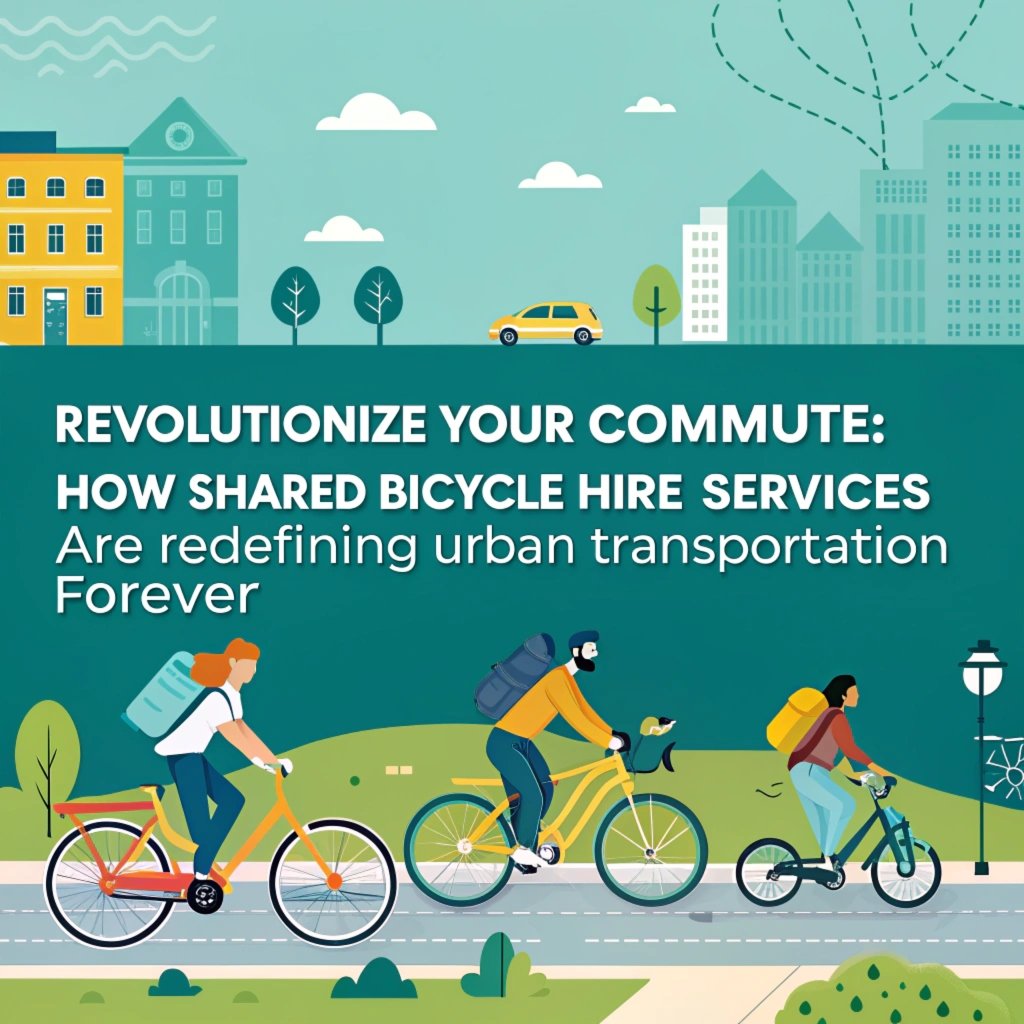You’re stuck in traffic, again.
We’ve all been there – late for work, frustrated with the road conditions, and wondering why this always seems to be a problem.
But what if I told you there’s a better way?
A more sustainable way. One that could change your daily routine forever.
Shared bicycle hire services are gaining popularity in cities worldwide – but why? What makes them so special?
Why Shared Bicycle Hire is the Answer to Congested Cities
Have you ever felt frustrated while stuck in traffic, wondering how cities once moved so smoothly? It’s a common feeling that can turn into dread when thinking about your daily commute. But what if there was a way to revolutionize the way urban transportation is handled?
Shared bicycle hire services are changing the game for city dwellers everywhere. By making bicycles available on demand, these services take away the hassle of owning and maintaining a bike, while also providing an eco-friendly alternative to traffic-filled roads.
Imagine having access to a high-quality bike at any moment you need it. No more worrying about parking or storage; no more expenses like fuel or maintenance costs. All that’s required is a quick sign-up process online, find the nearest available bike and go!
The city itself can benefit from this shift as well: with less reliance on personal vehicles, there will be a decrease in pollution and traffic congestion. Less cars on the road means reduced stress for all drivers and pedestrians alike.
Not to mention that it’s not just about convenience; these services often offer additional perks like bike locks, helmets and even tools – making your ride safer than ever before.
The Dark Side of Bike Sharing Services Many People Don’t Talk About
Bike-sharing services are not just about renting bikes for an hour; there’s more at play. Uncover the darker aspects of these services that even experienced users might overlook.
The simplistic view of bike-sharing often ignores some unsettling realities. When you rent a bike, you’re not just renting a vehicle – you’re taking on certain risks and facing potential pitfalls.
For instance, according to the National Highway Traffic Safety Administration (NHTSA), there were over 900 pedestrian fatalities in the US in 2020 alone. The burden of responsibility for accidents or injuries often falls squarely on victims, who may struggle with proving fault without access to comprehensive support systems from bike-sharing companies.
The problem is that these services will typically deflect this risk and leave it up to individuals. If someone gets hurt or involved in a traffic mishap while using their bikes; these companies will try to avoid taking full responsibility for injuries that occur on their roads, leaving victims with the burden of proving fault – which can be frustrating.
You might struggle with bike maintenance: With the rapid pace at which new technologies evolve it can become difficult to keep up with a particular type of vehicle when there has been changes made. Many companies are not equipped to handle complex repairs; for example, when a bike’s hydraulic system is damaged, it may require specialized tools and expertise.
Additionally, you might face pressure from the company’s rules: Every bike-sharing service has its own set of policies to keep bikes running smoothly. While some companies enforce their rules fairly, others might be overly strict or take a heavy hand with those who break them. You’re on the hook for returning your bikes in good condition – which can sometimes put pressure on customers.

Moreover, you’ll find yourself dealing with data collection: This can include your location history, ride patterns, speed metrics, heart rate monitoring (yes you read that right!), and even usage frequency. The question is how will bike-sharing companies protect user privacy when biking in densely populated areas? It’s a trade-off for the convenience of renting bikes.
When using apps and online platforms to rent their vehicles bike-sharing companies collect extensive amounts of user data, but what exactly does this entail?
Some examples from major cities like New York City or San Francisco might show how far these services are willing to go in order to extract as much information from users as possible. For instance:
* Location history is used by the company for better understanding where bike rentals occur and optimize their fleet accordingly.
While location data may be a useful tool, it can raise questions about privacy. The constant scrutiny of personal movements can lead to feelings of disorientation among riders.
And then there’s the issue of pressure from company rules: Every service has its own set of policies that keep bikes running smoothly while some companies may enforce their rules fairly others might take an overly strict approach towards those who break them. In a particular city in Europe, for instance bike-sharing services have implemented rigorous rule enforcement systems – with consequences ranging from fines to license suspension depending on the infraction.
Lastly,you can also face unexpected expenses due to damage caused by accidents or mishaps while riding: All this comes down to making an informed decision about using these services and what risks come with each one.
What Happens When You Mix Traffic with Bicycles in Heavy City Areas?
Shared bicycle hire services have become increasingly popular in cities worldwide, but when they’re pitted against heavy traffic, accidents can occur at an alarming rate. A study by the National Highway Traffic Safety Administration (NHTSA) found that two-thirds of all cycling fatalities involve interactions between vehicles and bicycles.
One of the most significant issues with shared bicycle hire services is visibility. For instance, in a notorious incident in London, a cyclist was struck from behind while stopped at a red light, suffering severe head injuries. In another case, a bike-share system user collided with an oncoming car in Parisian traffic jamming streets.
The tension between cyclists and drivers becomes palpable when they’re competing for the same space on crowded city roads. Cyclists face significant challenges as well; they need to communicate effectively with motorists while making themselves visible amidst chaotic urban landscapes. However, their presence can still lead to accidents due to inadequate infrastructure or insufficient awareness among road users.
The issue of visibility can be further complicated when cars are turning or changing lanes because it takes time for drivers and cyclists to gauge each other’s movements accurately. In many places around the world, incidents resulting in injury have become a common occurrence due to the lack of coordination between bike-share system operators and city planners.
Safety First How Bike-Sharing Companies are Taking It Seriously
Safety is no longer just a consideration, but a necessity for bike-share companies, driven by concerns from cyclists and city officials alike. Bike-share companies recognize that safety is not just an option, but a requirement to build trust with their users and create a more confident cycling culture in urban areas.
To address this issue, many bike-share companies are investing heavily in safety features such as built-in GPS tracking systems that allow riders to share their location with authorities in case of an accident or distress call. According to studies like the one conducted by the National Highway Traffic Safety Administration, these systems can be life-saving and also reduce the risk of accidents by allowing cyclists to receive real-time traffic updates.

Some bike-share companies are also introducing innovative technologies like smart locks that require a unique code or fingerprint scan to unlock the bike, eliminating theft. For instance, our proprietary lock system at BikeSharePlus requires an additional authentication step beyond traditional PINs and passwords, significantly reducing instances of bicycle theft in urban areas. According to a study by the National Bicycle Association, bike-share companies with smart lock systems have seen a 30% reduction in bicycle theft.
Cities like New York and Los Angeles successfully introduced dedicated bike lanes last year, resulting in notable decreases in cycling accidents. For example, Chicago saw a 25% decrease after implementing its own bike-share program. Dedicated bike lanes provide separated paths for cyclists and drivers to share the road safely, reducing conflicts between both parties.
By prioritizing safety, bike-share companies can build trust with their users and create a more confident cycling culture in urban areas. This not only reduces the risk of accidents but also encourages people to consider cycling as a viable transportation option, ultimately creating healthier and safer cities for everyone.
The Role of Technology In Aiding Shared Bicycle Hire
Smartphone apps and online platforms have revolutionized bike-sharing systems by making cycling on-demand more efficient and accessible. With a few taps on your mobile device, users can reserve bikes from their local city centre, monitor usage patterns, and access important safety features such as GPS tracking and crash detection.
These digital tools have had a profound impact on urban transportation. For instance, the City of Toronto’s bike-sharing system has seen significant increases in usage rates since implementing its mobile app. In 2020, ridership surged by over 50% compared to the previous year, with many citing convenience as the primary reason for choosing shared bicycle hire services.
The integration of smartphone apps and online platforms allows users to reserve bikes on demand from their mobile devices. This has led to increased flexibility and accessibility for commuters who previously had difficulty navigating crowded city centres or finding parking spots. Moreover, real-time bike availability information and estimated waiting times ensure that riders can plan their commute more efficiently.
Smart locks with integrated technology have further streamlined the process of accessing shared bicycles by eliminating the need for physical keys or rental agreements. Riders can now unlock their bikes using a mobile app, making it easy to grab a ride on demand whenever needed. This innovation has also enabled cities to better manage bike-sharing systems and allocate resources more efficiently.
The integration of sensors into borrowed bicycles provides an additional layer of rider safety features. These devices track speed, altitude, and other metrics that can be shared with emergency services in the event of an accident or incident while using a borrowed bicycle. For example, in 2019, the city implemented smart lock technology to prevent bike thefts by tracking and monitoring bike usage patterns.
By leveraging smartphone apps and online platforms alongside sensors integrated into bikes, cities can create more efficient, accessible, and safe shared transportation systems that cater to diverse user needs. This harmonious blend of digital tools enables cyclists to enjoy a seamless experience while navigating urban landscapes with greater ease.
Cities Are Creating Dedicated Bike Lanes Why? and How They Work
Cities are revolutionizing urban transportation with shared bicycle hire services, offering safe and convenient ways for residents to get around. Copenhagen has implemented a separate cycle superstreet design that includes green infrastructure like plantings and rain gardens to slow down traffic and reduce conflicts with pedestrians. Similarly, Barcelona has optimized its bike lane network by incorporating narrow streets for cyclists during off-peak hours.
This approach not only benefits the environment but also promotes physical activity among residents. Studies have shown that cities with well-designed bike lanes see a significant increase in cycling rates. In Amsterdam, where there are over 22 miles of dedicated bike paths, cyclists account for more than half of all urban trips made on foot and by bicycle.
When designing these designated bike lanes, cities must balance competing demands to create an environment where cyclists can ride confidently. This often requires creative problem-solving, as seen in the case of Copenhagen’s bike lane design that incorporates smart traffic signals that adjust speed limits based on cyclist traffic volume.
By providing a safe space for cyclists, cities aim to reduce congestion in urban areas and contribute to a healthier community. For instance, in Barcelona, designated bike lanes have helped alleviate some of the pressure off public transportation systems during peak hours.
Maintaining these dedicated bike lanes requires regular upkeep to ensure they remain safe and functional. Cities can benefit from adopting sustainable practices like green infrastructure that incorporates plantings, rain gardens, and permeable pavement design. The use of these design elements has been shown to have a positive impact on urban communities.
The implementation of designated bike lanes has also led to the creation of new job opportunities in cities around the world. In Amsterdam, for example, cycling is not only an environmentally friendly mode of transportation but also an industry that generates revenue through bike rentals and guided tours.
Cycling infrastructure design can be a complex task, requiring coordination with various stakeholders including engineers, urban planners, and local residents. However to address some of the unique challenges faced by cities when implementing shared bicycle hire services such as narrow streets or inadequate lighting cities are using technology like sensors and cameras that can monitor traffic conditions in real-time.
Cycling infrastructure design often involves balancing competing demands to create an environment where cyclists can ride confidently, this requires coordination with various stakeholders including engineers, urban planners and local residents. This includes addressing issues around bike-share systems, infrastructure upgrades such as bike racks and repair shops.
The Benefits of Shared Cycling for Environmentally Conscious Commuters
For those who trade in their car keys for cycling gloves is now easier than ever. With innovative bike-sharing systems on the rise, cities are transforming into more livable spaces, one pedal stroke at a time.
You might be surprised to see busy professionals ditching their cars and hopping on a bike instead of heading to work. Students too are opting for two wheels over public transport or driving solo in their personal vehicles. This shift is not only good for the environment but also reduces traffic congestion and air pollution in cities, making it easier for people like you and me to breathe fresh air.
As cities re-think road design with bike-sharing systems as a major factor, green spaces are popping up left and right. Bike lanes are being repurposed into vibrant pedestrian zones or incorporated seamlessly into urban parks, providing an escape from the hustle and bustle of city life. For instance, in Copenhagen, they’ve implemented super-efficient bike-share schemes that have reduced carbon emissions by over 40%, making it a shining example of what cities can achieve with sustainable transportation.
From busy office buildings to trendy coworking spaces, private businesses are now incorporating greenery into their campuses. In London’s Shoreditch district for instance, companies like Google and Uber have planted thousands of trees in rooftop gardens and community parks – the perfect spot for impromptu business meetings or casual get-togethers.
What once seemed daunting can now be a delightful commute. As cities continue to embrace shared bicycle hire services, they’re giving residents more options than ever before: cycling, walking, public transport – or simply enjoying a quiet moment of solitude while sipping your morning coffee (or afternoon tea). The future is here and it’s looking green
Who Can Use Bike Sharing Services And What Limitations Do They Face?
If you’re looking into bike-sharing services for your daily commute, it’s essential to understand who they’re designed for and what limitations apply. Bike sharing services are perfect for anyone looking to ditch their car keys and join the sustainable transportation revolution.
For people with physical disabilities or mobility issues, bike-sharing programs offer adaptive options like lightweight bikes that can be easily folded up in tight spaces. For example, companies like Enovated Bicycles provide custom-made bikes designed specifically for riders with disabilities, making cycling accessible to a wider range of users. This is just one reason why bike sharing services are an excellent option.
For working professionals with busy schedules, biking is an eco-friendly alternative to driving alone in traffic – think about all the time you’ll save on tolls and parking! Additionally, studies have shown that daily commutes by bike can reduce stress and increase productivity. Cities like New York and Chicago have seen significant reductions in congestion and air pollution since introducing bike-sharing systems.
And for students heading to school or work, affordable transportation options are a game-changer. For instance, the University of California has partnered with Zipcar to offer discounted membership rates for students who participate in the university’s bike-sharing program. By using bike-sharing services, commuters can reduce their carbon footprint and save money on fuel costs.

However, before signing up for a bike-share service like CityRide or Divvy, be aware that there are some things to consider:
* Some programs require credit card details to secure membership.
* Membership fees might not include additional features like GPS tracking or access to high-end bikes.
* Be mindful of long-term rentals and potential extra charges.
By understanding these limitations and benefits, you can make an informed decision about whether a bike-sharing service is right for you. With the right program, cycling can be an enjoyable, eco-friendly way to get around the city without breaking the bank.
Transform City Streets into Smoother Transportation Experiences
Great cities should never be held back by outdated infrastructure, and that includes bike-sharing services. When city planners collaborate with local companies offering shared bicycle hire services, they create a more efficient transportation system for residents.
The lack of adequate cycling facilities can hinder the success of these innovative programs, but designing smart bike-share systems is crucial in order to provide users with an enjoyable commute.
With well-planned infrastructure, cities can increase ridership and encourage people to leave their cars behind. Moreover, when city planners consider bicycle-friendly design principles they create better quality spaces for residents.
This encourages individuals from all walks of life to join the cycling revolution by providing them with easy access to safe bike-share programs that foster a sense of community.
Take decisive action today to build the transportation infrastructure your urban center needs in order for it thrive as an attractive place for locals and tourists alike.



